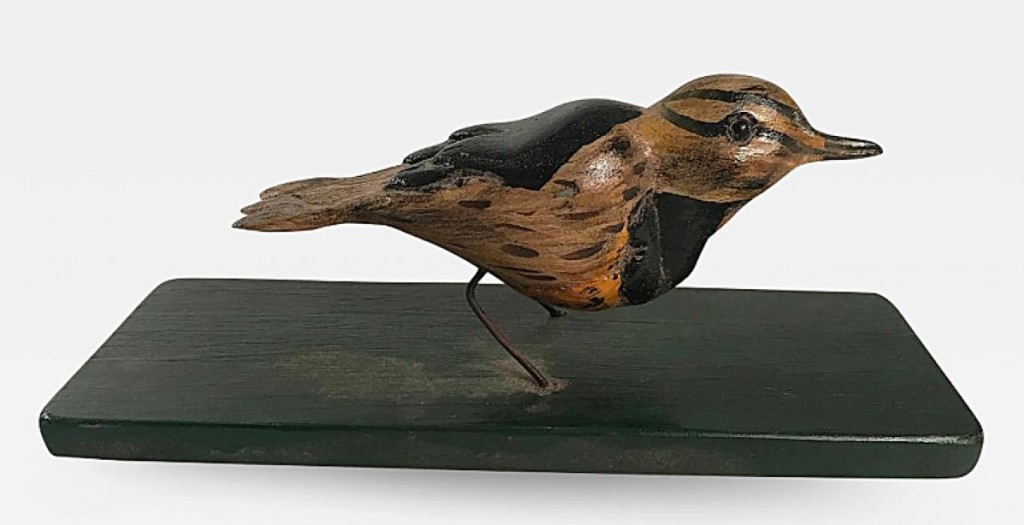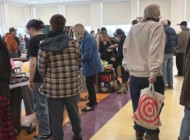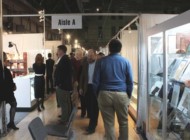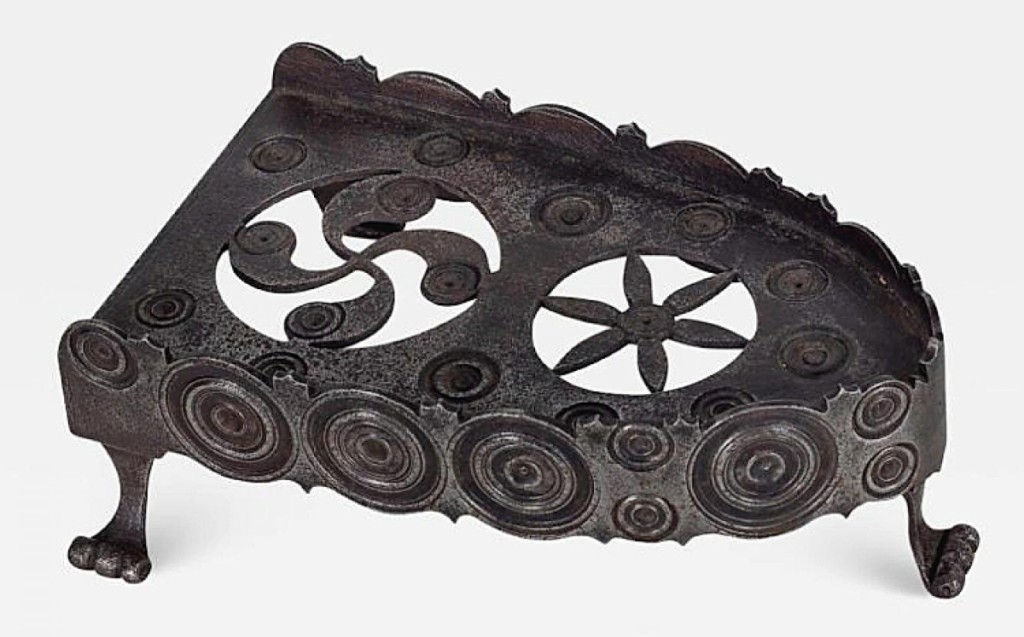
Elliott and Grace Snyder, South Egremont, Mass., called this English steel trivet a tour de force. It was a quick sale for the dealers, who said it was from the early Nineteenth Century and “exhibited the maker’s skill and imagination.”
Review by Greg Smith, Photos Courtesy Antiques In Manchester
ONLINE – Perhaps next August when you visit the Sullivan Ice Arena for Antiques in Manchester: The Collectors Fair, leave your partner in line and walk up the bleachers until you hit the mezzanine that overlooks the show floor. There are, of course, other shows in other venues where you can witness this vista, but I’m not sure there are any as kaleidoscopic or, indeed, macroscopic as this one. From that vantage, assuming the gate has opened now and your partner abandoned you without hesitation, you bear witness to a great experiment in desire: the collector in their natural habitat, navigating a human-sized maze as they alternate between a brisk rush and a careful study, while 600 others are doing the same. It could be an illustration in a Where’s Waldo? book. The action is backdropped by the varied wallpapers in the dealers’ booths, so many of them in bright and distinctive colors – a tell of their curatorial flair and their unique eye used to acquire and present the objects on the show floor.
There are aspects to an online show that don’t translate online – that vista, for one. The friends you see, another. The act of collecting and buying is more rounded than simply handing someone money and walking away with a treasure under your arm. Any show I have ever been to amounts to hours of looking and talking and a couple minutes spent buying. You like it or you don’t.
In the run up to the August 5-12 online show for Antiques In Manchester, that annual Wednesday opener in Antiques Week in New Hampshire at Saint Anselm College, show manager Karen DiSaia lamented that she was going to miss the show this year. She was not talking about the buying and selling, but the conversations in line, the friendly hellos and the quick chats over what someone bought. The reunion.
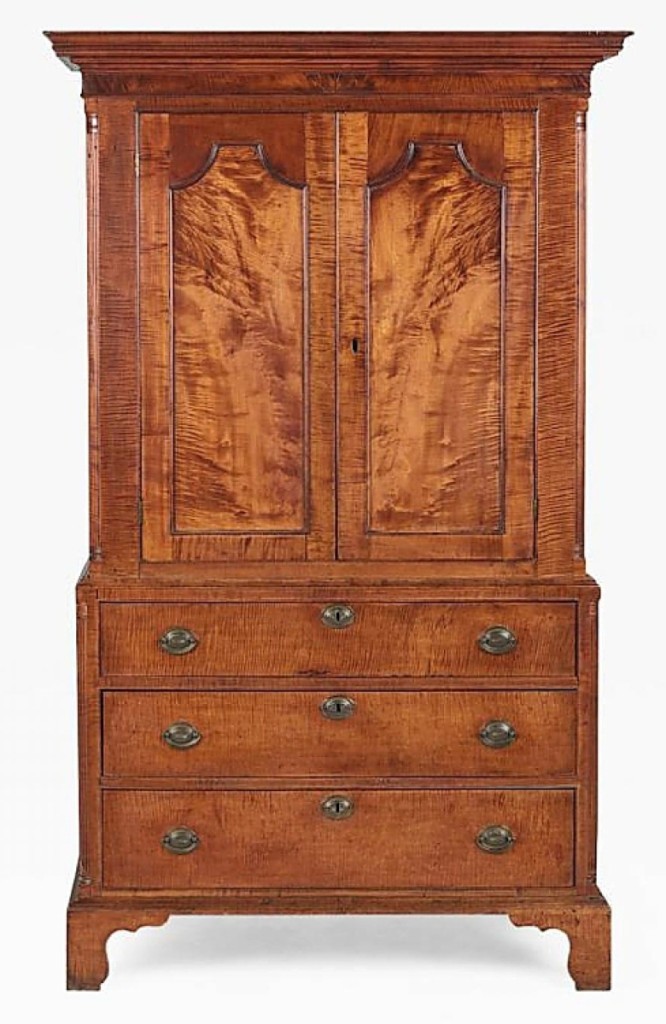
If the grain does all the talking, this tiger maple linen press could entertain any room. Taylor Thistlethwaite, Upperville, Va., sold this example from the Mid-Atlantic, circa 1880.
Her goal then became, in these nascent stages of online shows, to try to recreate that. The 1,065-item show was hosted on InCollect, where DiSaia made a novel effort to introduce something new in the online show circuit: video chatting. “In keeping with the show’s original theme of ‘making a connection,’ we are adding a direct live video chat feature that will allow collectors to virtually meet with the dealer at the stroke of a key,” DiSaia announced in her presale publicity. A selection of dealers would be online and at their desk for the first two days of the show in order to facetime with interested buyers and answer any questions they had in the moment.
This was a good idea. Many dealers continually lament that the online catalogs do not offer the means to demonstrate scale, highlight minutiae or properly communicate how special some of these things are.
But continuing in the spirit of 2020, life had other plans.
We have, by this point, established that a virus can put the show circuit on hold. But as the industry blazes trails in online retail and comes to know all of the hurdles, we can place firmly in that category nature. The day before the show opened, Tropical Storm Isaias rolled up the East Coast and through New England, where a sizable amount of the dealers reside, counting them among the two million people who lost power and internet that day and for days after. Many of the dealers who elected to do video chats were unable to participate.
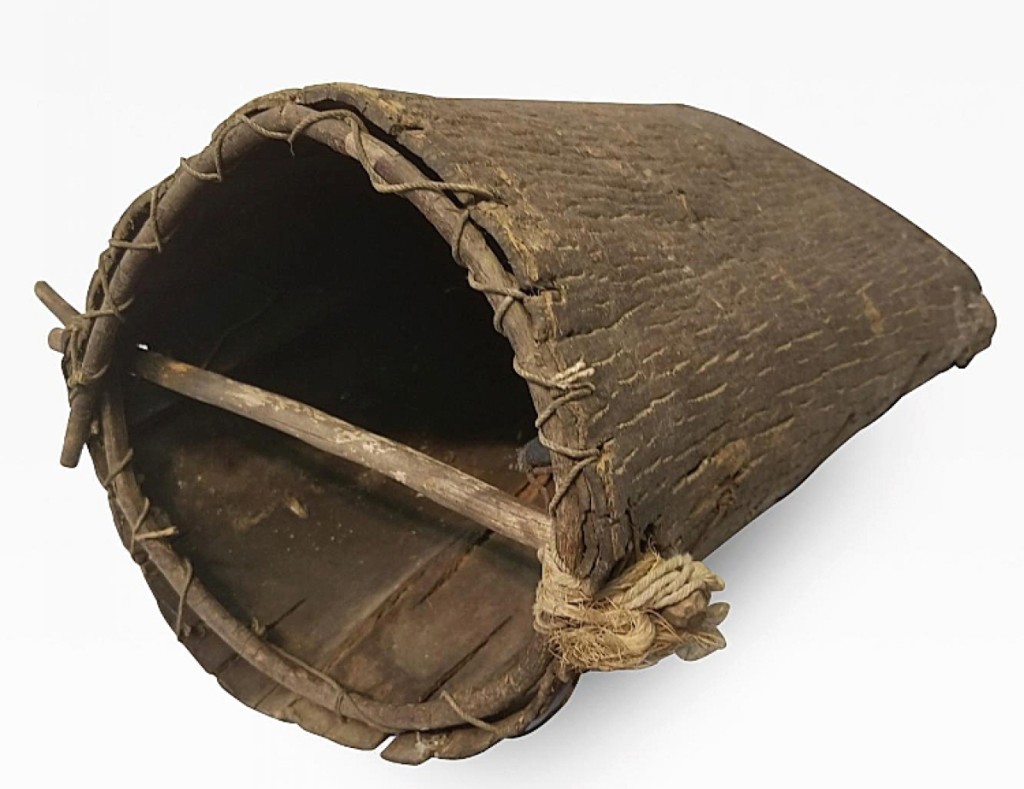
Lisa S. McAllister, Inc., Clear Springs, Md., sold this North Carolina bark basket. It measured 15 inches long and dated to circa 1900.
“The show got off to a rocky start,” DiSaia said, relating that her home was hooked up to a generator for the first five days of it.
But all was not lost. There’s a Mitch Hedberg joke that applies here: “I like an escalator because an escalator can never break, it can only become stairs.”
Even without the video chatting, the marketplace never lost power. Folks responded warmly to the 41-dealer show as it went on to log north of 100 sales over its run, making it one of the most successful high-end online antiques shows to have occurred over the last few months. Over 8,848 people visited the marketplace, which is over four times as many visit that the in-person show. The dealer storefronts had a combined 77,688 pageviews. The New Hampshire online shows, with their national appeal, were able to pull in interest from across the country.
Found among the 45 pages of goods were exemplary offerings of American folk art, formal and painted furniture, metalware, weathervanes, pottery, carpets, samplers, small boxes, paintings and much more.
Scott Ferris of J&R Ferris Antiques, Boonville, N.Y., tallied up eight sales, adding that it was the most successful online show the dealer has had recently. Among them was a Nineteenth Century molded silver birthing clamp in the form of a stork, used to tie off the umbilical cord of a newborn. Another sale was an oil on artist’s palette dated 1933 and featuring “Blue Eagle Cherokee Chief.” It was signed A. Bogart to the back, an unlisted artist. Ferris prized both of those pieces for their uniqueness, but his highest ticket sale came in the form of Canadian folk artist Maud Lewis’ 1960s mixed media on board titled “Collecting Maple Sugar,” which sold to a Lewis collector. Only one of the buyers had purchased from Ferris in the past. “I did very well,” Ferris told us, “even when compared to a typical show.”
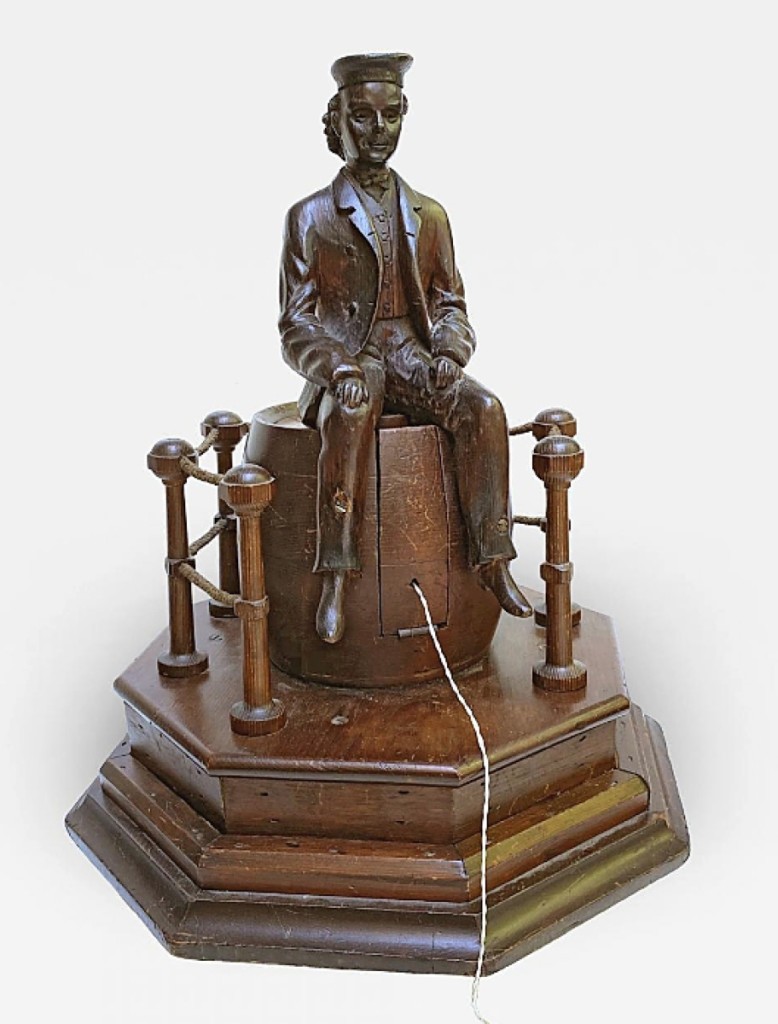
The only marked sale for Heller Washam, Portland, Maine, was a good one: this 19-inch-high figural string jack in the form of a Jack-Tar sailor or ship rigger sitting atop an upturned barrel. The dealer said it dated to the first half of the Nineteenth Century. It had a label on the bottom for “W.H. Brickett, Dealer in Clocks, No. 2 Bromfield Street, Corner of Washington (Boston).”
Litchfield, Conn., dealer Jeff Tillou made some sales, including an Eighteenth Century bird’s-eye maple treenware plate and a “Town Band” bandmaster whirligig, 14 inches tall in sheet metal, iron and polychrome paint that had provenance to American Primitive Gallery and the Mayer Collection.
Elliott and Grace Snyder, South Egremont, Mass., sold a fine early Nineteenth Century English steel trivet with cut out pinwheels and concentric circles throughout on paw feet. They thought it may have been Welsh. Other metalware that found a new home included an Eighteenth Century Gothic Dutch three-knop brass candlestick and an Eighteenth Century wrought iron fork with a heart-shaped central tine, likely from New York.
“I’m noticing people are responding to very good things,” Grace Snyder said. “There’s quite a lot of pent up demand out there. It’s not easy to find that material.”
Snyder said her sales were largely to existing clients. When the storm blew in and knocked out the dealers’ power for two days, she set up in the shop of Sam Herrup, who was also selling at the show.
Of the three pieces of stoneware marked sold, Dan and Karen Olson, Newburgh, N.Y., sold two. One was a cobalt-decorated jug, 9¼ inches high, stamped with the mark of New York City potter Clarkson Crolius Jr. The other was a 3-gallon Bennington crock in perfect condition with a profuse and dark cobalt floral decoration.
Peter Eaton, Wiscasset, Maine, sold the third, a Nineteenth Century double-handled jug stamped Charlestown above three heart stamps. The top of the jug was dipped in an Albany slip. Eaton’s other sales included an eight-legged Windsor settee that the dealer said was likely from Philadelphia, circa 1765-80. Eaton said a nearly identical example was in Santore’s The Windsor Chair in America, Vol. II.
Other furniture sold, including a Mid-Atlantic Nineteenth Century tiger maple linen press from Taylor Thistlethwaite, Upperville, Va. Also in tiger maple was a Nineteenth Century drop leaf table with a highly figured top that sold from Emele’s Antiques, Quakertown, Penn. Norman Gronning, Shaftsbury, Vt., moved along an Eighteenth Century Chippendale pine raised panel two-door hanging wall cupboard in white paint, circa 1760. A bold Nineteenth Century paint-decorated mule chest from Maine sold at J.K. Nevin Antiques, Pottstown, Penn. A paper accompanied the chest that said it was made by Gersham Flagg of Windslow, Maine, for his daughter Sarah Pond Flagg Towne, around 1850. Diminutive things are always desirable, and The Hanebergs Antiques, East Lyme, Conn., sold a Nineteenth Century miniature tilt top candlestand in mahogany with an inlaid top, 11½ inches tall with the top down.
Four weathervanes sold in the show run, with buyers preferring early Twentieth Century graphic examples. Included here was a fine carved wood and polychrome painted peacock roof ornament or weathervane sold by Tillou, 33 inches high and from the early Twentieth Century, with provenance to American Primitive Gallery and the Mayer Collection. Firehouse Antiques, Galena, Md., also moved along an early Twentieth Century vane featuring a sheet metal running fox. A flat copper Indian on horseback weathervane, circa 1900-19, sold from American Spirit, Shawnee Mission, Kan. The oldest example to sell was a Nineteenth Century Ethan Allen running horse vane with an untouched verdigris surface, sold by John Hunt Marshall, Florence, Mass.
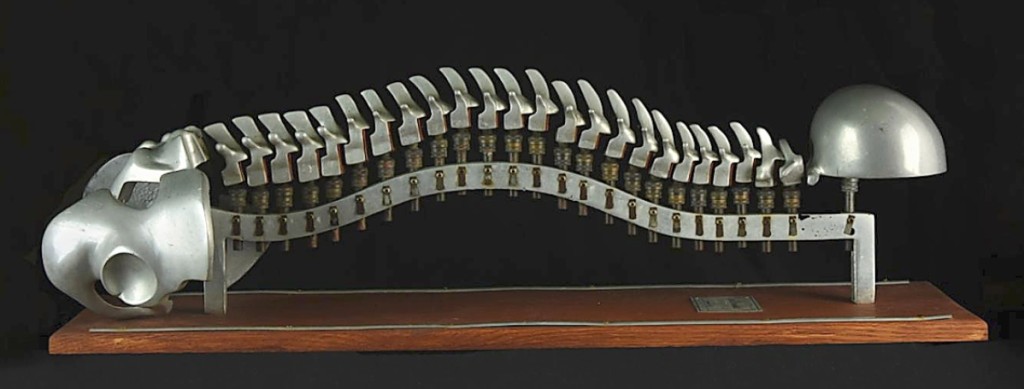
This life-sized aluminum spinal demonstrator was sold by Steven S. Powers, Brooklyn, N.Y. It was invented by George Thurman Fleet in San Antonio, Texas, patented in 1938. The movable vertebrae were each on a brass piston projecting from a square tube.
American Indian pieces found interest as well, ranging from baskets to burl bowls. In baskets, a diminutive Northeastern Indian basket, 3½ inches high in woven splint with blue, green and red vegetable dyes, sold from Sheridan Loyd, St Joseph, Mo. Three Twentieth Century baskets had a sold tag on them from Willow Springs Perennial, Rexford, N.Y., including a small melon basket, probably Cherokee; a Taconic swing handle signed and dated 1917; and an unusual lidded buttox. Dan & Karen Olson sold a Taconic wood splint herb basket from the Nineteenth Century. Clear Spring, Md., dealer Lisa S. McAllister sold a good North Carolina bark basket from the early Twentieth Century, 15 inches long.
Sales in burl included an Eighteenth Century handled pine bowl in an unfinished surface from the Great Lakes region, offered from Country Cupboard Antiques, Portsmouth, N.H.; and a 20-inch diameter double-handled ash burl bowl from the Northeast, late Eighteenth Century, that sold from Elliott and Grace Snyder.
Dealers reported a job well done for show manager Karen DiSaia, who said she was thrilled to put on the show for the buyers and dealers.
“All things evolve,” DiSaia told us after the fair. She said she may elect to do a virtual marketplace in the future that coincides with the physical show.
When asked if she heard any feedback from collectors, DiSaia said she had not heard much of anything at all, a product of the digital age where communication is so often targeted and intentional, plainly contrasting with the spontaneous and social nature that make up, in part, the soul of an antiques show. She said she looks forward to next year, when that soul can be felt not through a screen, but by looking someone in their eyes and taking part in the shared experience of connecting.
For additional information, www.antiquesinmanchester.com.

